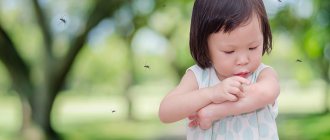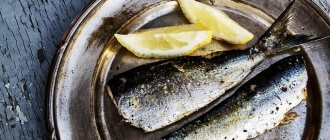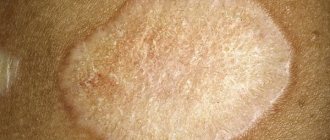body .attr-article__date{ background: none; padding: 0; }
NEAD EAD SEAD South Administrative District South-Western Administrative District CJSC Central Administrative District SZAO Northern Administrative District 01 02 03 05 06 07 08 09 1 0 1 1 1 2 14 18 15 16 17 Babushkinskaya Prospekt Mira Pervomaiskaya Baumanskaya Paveletskaya Teply Stan Shipilovskaya Prague Academic University Barrikadnaya River Station Oktyabrskoye Bratislava Taganskaya Academician Yangelya October Field
The call center is open 24 hours a day
Ambulance 24/7
Home Health from A to Z Useful information Hypoallergenic diet according to A.D. Ado
Publication date: 05/21/2021
until January 31
You get 10% cashback when purchasing a gift certificate More details All promotions
Allergic urticaria
The child is prescribed a hypoallergenic diet according to A.D.
Ado. Food allergens to which the body reacts and histamine-releasing products should be excluded from the diet. The medications prescribed depend on how severe the child's hives are. In case of exacerbation of severe urticaria, take some of the following medications (as prescribed by a doctor):
- clemastine
— chloropyramine 2.5% (course 5-7 days)
- systemic glucocorticosteroids (if the above drugs were ineffective): dexamethasone, prednisolone
- according to indications, hemodez 200-400 ml intravenously, 3-4 injections
- fexofenadine (Telfast)
- loratadine (Claritin) once a day
- ketotifen
For the treatment of exacerbations of moderate urticaria, take:
— clemastine (tavegil) 0.1%
— chloropyramine (suprastin) 2.5%
— systemic glucocorticosteroids (according to indications)
- fexofenadine
- loratadine
- ketotifen (zaditen) 0.001 g 2 times a day
In case of mild exacerbations of urticaria, elimination measures are carried out. Glucocorticosteroids are not used. Then fexofenadine (Telfast) and loratadine are used once a day. Course – 1 month. Ketotifen is taken for a course of 3 months.
Treatment in a hospital is 18-20 days. If necessary, SIT and a course of histaglobulin are carried out in an allergy hospital or office.
Diet for food allergies
When the body encounters substances that cause a hypersensitivity reaction, a rash appears on the integument, accompanied by redness of the skin and severe itching. These are the main manifestations of food allergies that occur after ingesting foods and drinks.
Diet can fully or partially correct a person’s condition. But you will have to follow its rules strictly, otherwise the result will be questionable.
Nutritional Features
To minimize existing risks, it is recommended to contact an allergist and have tests done.
Idiopathic urticaria
To treat this type of urticaria, the child must follow a hypoallergenic diet according to A.D. Ado. The same medications are recommended as for the treatment of exacerbations of moderate urticaria. In case of torpidity, the child may be prescribed long-acting glucocorticosteroids for a course of 2-3 weeks to symptomatic therapy.
Detoxification therapy involves the administration of hemodez 400 mg and the intake of sorbents. The child is prescribed digestive enzymes, for example, mezim or festal, but not in all cases. Based on the identified pathology, the child is prescribed symptomatic treatment: antifungal, antibacterial, etc.
If treatment with antihistamines is effective, then a course of histaglobulin follows.
When to sound the alarm?
It is impossible not to notice the manifestations of nettle fever.
Redness and then blisters appear on the child's skin. Rashes appear in the folds of the skin, on the lips, and in places of close contact with clothing. The body itches a lot, hence another name for it - infant pruritus .
Often parents do not pay attention to this.
Moreover, the rash usually disappears after a few hours , but soon appears in a new place.
There is no need to panic, but you should see a doctor as soon as possible.
Temperature urticaria
As with the types of urticaria described above, the child follows a diet according to A.D. Ado. You should adhere to a gentle thermal regime, avoiding high and too low temperatures. If the effect of thermal factors on the body is inevitable, antihistamines should be taken before contact. In cases of photodermatosis, photosensitizing drugs are discontinued.
For the generalized form, take clemastine 0.1% 2 ml, chloropyramine (suprastin) 2.5%, dexamethasone, prednisone. For mild to moderate cases, take fexofenadine and loratadine once a day. Doctors may also prescribe antihistamines with a stabilizing effect on mast cell membranes.
How does an acute food allergic reaction manifest?
One of the most common external manifestations of an acute allergic food reaction is acute urticaria and Quincke's edema. These diseases are a serious problem for modern pediatricians and allergists-immunologists. The prevalence of urticaria and allergic edema in children in our time is, according to various authors, from 2 to 7%. Such a high frequency has never been observed before.
The rapid increase in the incidence of acute urticaria and Quincke's edema, according to many experts, is due to a number of reasons.
Let's highlight the most significant of them:
- exposure to industrial and household reagents
- widespread use of dyes, flavor enhancers and preservatives in the food industry
- Irrational and early artificial feeding of children of the first year of life
- uncontrolled use of antibacterial and anti-inflammatory drugs (antibiotics, immunostimulants)
- the influence of concomitant chronic pathology, primarily the early development of diseases of the digestive system.
Traditionally, urticaria is divided into acute, which lasts no more than 6 weeks, and chronic (over 6 weeks). Acute forms account for up to 80 - 90% of all cases of urticaria, chronic forms - from 5 to 25% (depending on the region and the degree of development of early diagnosis). According to the pathogenetic mechanism, allergic (immunological) and non-allergic (pseudoallergic) urticaria are distinguished. Allergic urticaria in children is often acute, while chronic urticaria in 90% of clinical cases remains of unclear etiology, that is, it is not actually allergic.
One of the main factors involved in the pathogenesis of urticaria is the internal “activator” of allergic reactions - histamine, which is contained in the granules of mast cells and basophils.
The classic IgE-dependent mechanism for the development of allergic reactions involves the participation of immune cells - B-lymphocytes, which produce special antibodies - immunoglobulins E against various protein molecules that enter the body through food and other means. Modern science was able to recognize these specific IgE antibodies and learned to determine them in vitro, which in practice led to the emergence of tests such as “Immunocap” and others, based on the results of which we can determine the individual reaction of the immune system to certain allergens.
However, in some cases, degranulation of mast cells, that is, the release of histamine, occurs not due to the contact of these cells with IgE antibodies, but due to the direct effect of a number of drugs, food colorings and preservatives on them. Medicines with direct histamine liberation properties include codeine, morphine, coumarin anticoagulants, various dextrans (reopolyglucin), penicillin, polymyxin, indomethacin, sulfonamides, B vitamins, and radiocontrast agents.
Many chemicals that the modern food industry cannot do without—preservatives—have a similar effect.
It has long been known that a common cause of urticaria is acetylsalicylic acid. However, not everyone knows that synthetic salicylates are widely used to extend shelf life in the factory production of caramel, chocolate, chewing gum, margarine, cakes, gelatin, mayonnaise, caviar, canned vegetables, meat and fish, cheeses, instant coffee, milk, curdled milk and other products. It should also be borne in mind that a number of fruits and vegetables contain natural salicylates, the highest concentrations of which are found in bananas and green peas.
| Preservatives | Sulfites and their derivatives (E220-E227), nitrites (E249-E252), benzoic acid and its derivatives (E210-E219), E200, E203. |
| Antioxidants | E311, E320, butyl-hydroxytoluene - E321. |
| Dyes | Tartrazine (E102), yellow-orange (E110), azorubine (E122), amaranth (E123), red cochineal (E124), diamond niello (E151), E127. |
| Flavors | Cinnamon, vanilla, menthol, cloves, glutamates (E550-E553). |
| Flavor stabilizers | E620, E625, E626, E629, E630, E633. |
Often acute urticaria and even angioedema develop during the treatment of acute respiratory viral infections, in which children under 4 years of age, according to WHO recommendations, are required to be prescribed medications (antipyretics, sputum thinners, antibiotics) and other drugs exclusively in liquid and, as a rule, very sweet forms with a specific taste and aroma. The result of such treatment can be the appearance of profuse, itchy rashes on the skin, which sometimes cannot be eliminated for several weeks or even months.
Allowed products for urticaria
Here's what all categories of patients can eat for urticaria - both adults and children:
- light-colored vegetables (except for sweet peppers) - onions, potatoes and cucumbers, squash, any cabbage (except orange varieties), lettuce, greens and peas.
- light berries and fruits - apple and pear fruits, white cherries, light currants;
- low-fat poultry and meat;
- any porridge, with the exception of semolina;
- hard pasta;
- quality whole grain bread;
- olive and sunflower oils;
- kefir and curd products;
- weakly brewed tea.
Sugar can be replaced with plant-based alternatives like stevia.
Your doctor should give precise instructions on what you can eat if you have an allergy-urticaria and what you can’t.
From the above components you should make dietary dishes, steamed, stewed or boiled. As a last resort - in the oven. The maximum proportion should be vegetable soups in non-meat broth, salads with unrefined oil dressing, as well as stewed vegetable mixtures. In second place are porridge and cooked meat.
Recipes for kids
It is worth noting that the diet for urticaria in infants is individual. It is worth limiting salt and sugar. Replace sugar with fructose.
Cream soup
Ingredients:
- 2 chopped leeks;
- 3 large potatoes, pre-soaked and peeled in cold water;
- 2 tablespoons olive oil, a little salt.
Heat the oil in a saucepan, add the chopped white part of the leek and diced potatoes. Simmer for 5 minutes.
Add 0.5 liters of water and cook for about 15 minutes. In a blender, or using a masher, bring the soup to the consistency of puree. When serving, add butter and herbs.
Vegetable cream soup
Ingredients:
- potatoes - 2 pcs;
- pumpkin - 40g;
- squash - 40g;
- cauliflower - 40g;
- hypoallergenic milk formula, salt.
Boil the potatoes together with cabbage, disassembled into inflorescences.
Scald the pumpkin and squash with boiling water and simmer. Boiled and stewed vegetables, stir. Dilute the milk mixture with vegetable broth and add puree.
Apple soup with turnips
Ingredients:
- turnip - 80g;
- egg yolk - 1 pc;
- flour - 1 tsp;
- apple - 1 piece;
- butter, salt - to taste.
Peel the turnips and cut into large pieces, boil and grind until smooth.
Beat the yolk with flour, add to the broth in a thin stream, bring to a boil, add turnip puree, grated small green or yellow apple, butter, salt.
Rice porridge with apple
Ingredients:
- rice - 2 tbsp. l;
- water - 1 glass;
- small apple - 1 piece;
- salt - to taste.
Rinse the rice. Pour water, peeled diced or julienned apples, and cook over low heat for half an hour. Add salt.
Pumpkin millet porridge
Ingredients:
- millet - 2 tbsp. l;
- water - 1 glass;
- pumpkin - 200g;
- salt - to taste.
Boil the cereal. Scald the pumpkin and grate it on a very fine grater. Peel the apple and cut into small strips. Add vegetables to the prepared porridge, add salt and butter.
Spaghetti with cheese sauce
Prepare cheese sauce.
From two tablespoons of cream and a tablespoon of finely grated unsalted cheese.
Add salt.
Heat in a water bath until a homogeneous mass is obtained.
Season the cooked spaghetti.
Rabbit casserole
Ingredients:
- rabbit fillet - 70 g;
- potatoes - 4 pcs;
- onion - 1 pc.
Boil the rabbit meat and grind in a meat grinder. Fry the onion in olive oil, mix with meat, add salt. Boil the potatoes and crush them. Place some of the puree into a greased form, place the minced meat on top of it, and cover with the remaining potatoes. Pour in low-fat sour cream or cream. Bake in the oven for about 20 minutes.
Chicken cutlets
Ingredients:
- white chicken meat - 150g;
- small onion - 1 piece;
- a slice of stale white bread;
- 1 egg.
Soak the loaf in milk. Make minced meat, bread, eggs, and onions. Add salt and form small cutlets. Bake for half an hour on a baking sheet with water at 220°.
Oat cookies
Ingredients:
- oatmeal - 2 cups;
- kefir or sour cream - 3 tbsp. spoons;
- egg - 1 pc (if you can’t, you can do without it);
- butter - 100g;
- sugar - 60 g;
- flour - ½ cup; a few grains of soda.
Grind the oatmeal and melt the butter. Mix. Finally, add soda, salt, and raisins as desired. Grease a baking sheet with oil and spoon out the dough.
Approximate menu for the week
Diet for urticaria is an important issue for a child. It is necessary to completely eliminate foods that may cause allergies. The diet must contain hypoallergenic or neutral products.
We present to your attention a weekly menu, what a child can eat with hives.
Monday
Breakfast : corn porridge, kefir.
Lunch : banana.
Lunch : chicken soup, oatmeal cutlets, unsweetened tea with a bagel.
Afternoon snack : rice pudding, tea.
Dinner : buckwheat porridge with fish balls, tea, crispbread.
Tuesday
Breakfast : rice porridge, tea with biscuits.
Lunch : mashed green apple.
Lunch : vegetable broth, fresh cabbage salad, boiled chicken, prune compote.
Afternoon snack : pumpkin curd, tea.
Dinner : baked potatoes with steamed sole, tea with homemade oatmeal cookies.
Wednesday
Breakfast : corn porridge, green tea with crackers.
Lunch : yogurt, green apple.
Lunch : pumpkin soup, turkey cutlets, green salad, tea.
Afternoon snack : baked green apples.
Dinner : pasta with apple sauce with steamed meatballs, green tea.
Thursday
Breakfast : oatmeal porridge, tea, biscuits.
Lunch : baked yellow or green apple
Lunch : fresh cabbage soup, vegetable stew with chicken, tea.
Afternoon snack : unsweetened tea, bread.
Dinner : mashed potatoes with meatballs, unsweetened tea
Friday
Breakfast : pearl barley porridge, tea.
Lunch : acidophilus.
Lunch : cucumber salad, cauliflower soup with rolled oats, tea.
Afternoon snack : cottage cheese casserole, apple compote.
Dinner : stewed spinach, chicken in sour cream, tea
Saturday
Breakfast : zucchini casserole, green tea with dried bread.
Lunch : yellow cherry or green apple.
Lunch : vegetable broth with rice balls, fruit juice or tea.
Afternoon snack : Kefir jelly (Mix kefir with sugar, natural yogurt, gelatin, refrigerate until frozen).
Dinner : baked cod with green beans, jelly or tea.
Sunday
Breakfast : buckwheat porridge with water, mild cheese, green tea.
Lunch : cottage cheese with grated apple.
Lunch : chicken soup with broccoli and zucchini, unsweetened tea.
Afternoon snack : acidophilus.
Dinner : buckwheat casserole with chicken, compote or tea.
Products contraindicated for urticaria
If urticaria is of the allergic type, food that is not tolerated by the body is initially removed. This is verified by laboratory testing or an experimental menu.
The diet for urticaria contains a list of foods recommended for exclusion in all forms of pathology:
- salt;
- animal oil;
- sour cream products and cream (both fat and low fat);
- semolina;
- alcoholic drinks;
- caffeinated products;
- smoked, spicy and fried;
- sausage and offal;
- mushrooms;
- eggs;
- baked goods and sweets;
- honey products and nuts;
- some vegetables (sweet peppers, tomatoes, celery);
- a number of fruits and berries (citruses, pineapple, grapes and strawberries, peaches with nectarines and apricots, raspberries, dark currants, watermelon, kiwi and oriental persimmons).
These products should be treated with particular caution when creating a diet for acute urticaria.
It is also recommended to exclude foods with a high histamine content:
- cheese products;
- fish and shellfish;
- fermented milk (especially yogurt);
- buttermilk;
- chocolate products;
- products with synthetic dyes;
- red meat.
In cases of stress-related urticaria, it is recommended to avoid foods that stimulate the nervous system - caffeine-containing foods, sweets, too salty foods, alcohol, seasonings and spices.
Find out more









